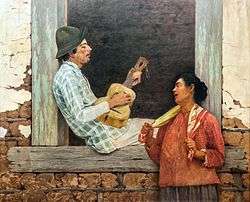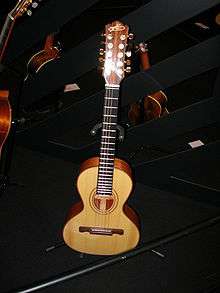Viola caipira

The viola caipira (Portuguese for country guitar) is a ten-string, five-course guitar.[1] Unlike most steel-string guitars, its strings are plucked with the fingers of the right hand similarly to the technique used for classical and flamenco guitars, rather than by the use of a plectrum.
It is a folk instrument commonly found in Brazil, where it is often simply called viola.[2] Resonator models are also produced.
The origins of the viola caipira are obscure, but evidence suggests it evolved from the vihuela/viola de mano that Spanish and Portuguese settlers took to the new world. It has also similarities with the 5 course baroque guitar, that elsewhere evolved into the modern guitar. It is likely a descendant of one of the many folk guitars that have traditionally been played in Portugal. The viola braguesa and viola amarantina, for instance, are two types of ten-string guitars from the north of Portugal,[3] which are closely related to the viola caipira.
Some have described the viola caipira as Brazil's national instrument,[4] but others argue that the tambourine-like pandeiro has a stronger claim.[5][6][7][8] The Brazilian Embassy in Washington lists a national flower among the official symbols of Brazil, but no national musical instrument.[9] What is undisputed is that the viola caipira was introduced in São Paulo before the violão, and is the basis for the música caipira, or São Paulo´s folk music, as Inezita Barroso states.
A large number of tunings are used; open tunings are common.[10]
Violas are present in nearly all Brazilian music forms, anywhere in the country (although it is declining in some places). It most often associated with Caipira Music (Brazilian country music), with some forms of North-Eastern music and with folkloric music. It was once used to play urban music, like choro, samba and Maxixe, but has been replaced by the acoustic guitar.
Well-known players of Brazilian viola include Zé Côco do Riachão (composer from Minas Gerais), Toninho Ramos (composer from Minas Gerais live in France) and Almir Sater (successful singer-songwriter from Mato Grosso do Sul).
A National Association of Viola Players (Associação Nacional dos Violeiros) has been founded in 2004 and the Ministry of Culture has declared the preservation of the Viola tradition as of national interest.
Notable performers



- Almir Sater
- Andréa Carneiro
- Braz da Viola
- Bruna Viola
- Chico Lobo
- Helena Meireles
- Fernando Sodre
- Heraldo do Monte
- Inezita Barroso
- Ivan Vilela
- Fabienne Magnant (France)
- Mazinho Quevedo
- Nestor da Viola
- Ramon Thiesen
- Renato Andrade
- Renato Teixeira
- Roberto Corrêa
- Teddy Vieira
- Tião Carreiro (artistic name of José Dias Nunes)[11]
- Toninho Ramos
- Zé Mulato
- Bruna Viola
See also
References
- ↑ Corrêa, Roberto (2000). A Arte de Pontear Viola (in Portuguese) (by the author ed.). Brasília. p. 259. ISBN 85-901603-1-9.
- ↑ Moura, Reis (2000). Descomplicando a Viola: Método Básico de Viola Caipira (in Portuguese) (by the author ed.). Brasília. p. 62. ISBN 85-901637-1-7.
- ↑ See Lark in the Morning
- ↑ See for example Brad Hoyt's essay which also includes some photos of the viola caipira
- ↑ http://www.brazilproductions.com/html/instrument.html
- ↑ "Pandeiros for Sale". Musicoutfitters.com. Retrieved 2014-03-30.
- ↑ "CharlieHunter.com". CharlieHunter.com. Retrieved 2014-03-30.
- ↑ MusicLink - http://www.musiclink.co.uk. "Programming natural sounding percussion parts". Petelockett.com. Retrieved 2014-03-30.
- ↑ Brazilian Embassy website
- ↑ Rosso, Piede (2009-02-08). "The Jazz Guitar Blog: Tuning". Jazz-guitar-talk.blogspot.com. Retrieved 2014-03-30.
- ↑ "Tiсo Carreiro- Portal". Tiaocarreiro.com.br. 1993-10-15. Retrieved 2014-03-30.
External links
- Boa Música Brasileira in Portuguese
- Brazilian Musician Viola Player in Portuguese
- Junior da Violla Playing Song "Luzeiro" From Almir Sater (YouTube Video)
- Brazilian Rock Band Charme Chulo Playing "Polaca Azeda" Using Brazilian Viola (YouTube Music Video)